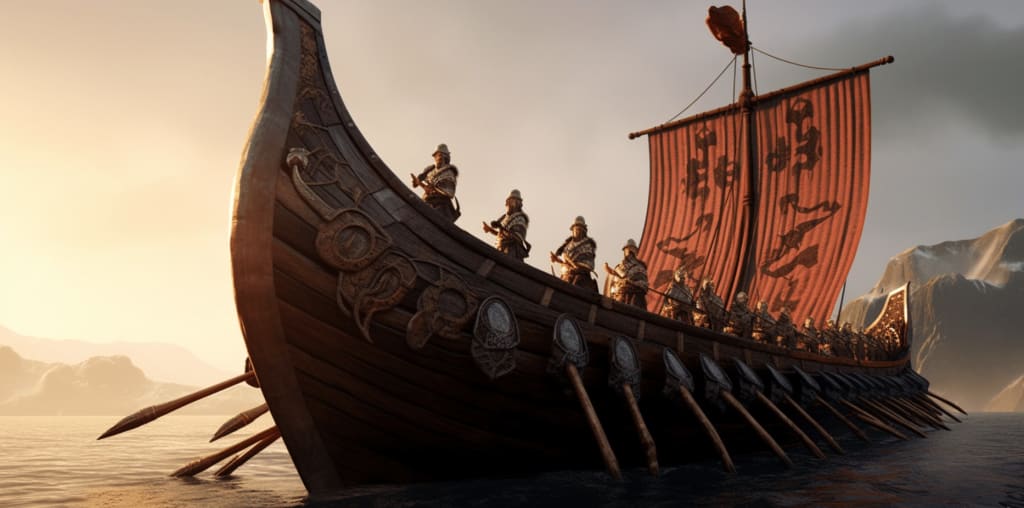Viking Longships: Masterpieces of Norse Seafaring and Exploration
History

Viking longships, iconic vessels of the Norsemen, were instrumental in shaping the Viking Age (8th to 11th centuries CE) and establishing the Vikings as formidable maritime explorers, traders, and raiders. These versatile ships were central to Viking society, enabling expeditions across vast distances and facilitating cultural exchange throughout Europe and beyond. This article delves into the origins, design, construction, navigational prowess, cultural impact, and enduring legacy of Viking longships.
Origins and Historical Context
Viking longships emerged during the early medieval period in Scandinavia, where maritime culture and seafaring traditions were deeply ingrained. The design of longships evolved from earlier Scandinavian boat-building techniques, adapted to suit the needs of Viking exploration and warfare. They played a pivotal role in the expansion of Viking influence across Europe, from raiding coastal villages to establishing trade routes and settlements.
Design and Construction
Viking longships were renowned for their advanced design and craftsmanship:
- Long and Narrow: Longships were characterized by their sleek, narrow hulls, which allowed for exceptional speed and maneuverability. They were typically constructed using overlapping planks (clinker-built) fastened with iron rivets, enhancing their durability and flexibility in rough seas.
- Versatility: Longships varied in size, from smaller vessels used for coastal navigation and river travel (karvi) to larger warships capable of carrying up to 100 warriors and provisions for extended voyages (drekar). Their shallow draft enabled them to navigate both open seas and shallow rivers, facilitating raids and exploration deep into continental Europe and beyond.
- Propulsion: Longships were propelled primarily by sail, supported by oars for additional speed and maneuvering in combat or calm waters. The sails were typically made from wool or linen, allowing for efficient harnessing of wind power.
Navigational Prowess and Exploration
The design of Viking longships enabled unprecedented feats of navigation and exploration:
- Transoceanic Voyages: Vikings used longships to navigate the North Atlantic, reaching as far as Iceland, Greenland, and even North America (Vinland). These voyages were made possible by their navigational skills, knowledge of winds and currents, and use of natural landmarks and celestial navigation techniques.
- River Routes: Longships were equally adept at navigating inland rivers, allowing Vikings to penetrate deep into continental Europe, establishing trade networks and founding settlements in regions such as Russia (Rus') and the Baltic.
Cultural Impact and Military Superiority
Viking longships had profound cultural and military significance:
- Military Superiority: The speed, agility, and maneuverability of longships gave Vikings a strategic advantage in raids and warfare. They could swiftly approach coastal targets, conduct surprise attacks, and retreat quickly if necessary, striking fear into their adversaries.
- Cultural Exchange: Longships facilitated cultural exchange between Scandinavia and other regions of Europe. Vikings traded commodities such as furs, amber, and slaves, while also importing luxury goods and cultural influences that enriched Norse society.
Enduring Legacy and Modern Representation
The legacy of Viking longships endures in several ways:
- Archaeological Discoveries: Excavations of Viking ship burials, such as those at Oseberg and Gokstad in Norway, have yielded remarkably well-preserved longships, providing valuable insights into their construction techniques, design evolution, and cultural significance.
- Cultural Symbolism: Viking longships have become enduring symbols of Norse exploration, resilience, and maritime prowess. They are celebrated in modern depictions of Viking culture in literature, films, and popular media, perpetuating their legacy as iconic vessels of the Viking Age.
Conclusion
Viking longships represent the epitome of Norse maritime ingenuity and exploration. These sleek, versatile vessels enabled Vikings to navigate vast oceans and inland waterways, expanding their influence across Europe and beyond. As symbols of adventure, conquest, and cultural exchange, longships continue to captivate imaginations and inspire admiration for the seafaring achievements of the Vikings. Their legacy as masterpieces of naval engineering and icons of Viking culture underscores their enduring significance in maritime history and the collective memory of human exploration.
About the Creator
Marveline Merab
“History never repeats itself. Man always does.”
― Voltaire
Enjoyed the story? Support the Creator.
Subscribe for free to receive all their stories in your feed. You could also pledge your support or give them a one-off tip, letting them know you appreciate their work.






Comments
There are no comments for this story
Be the first to respond and start the conversation.